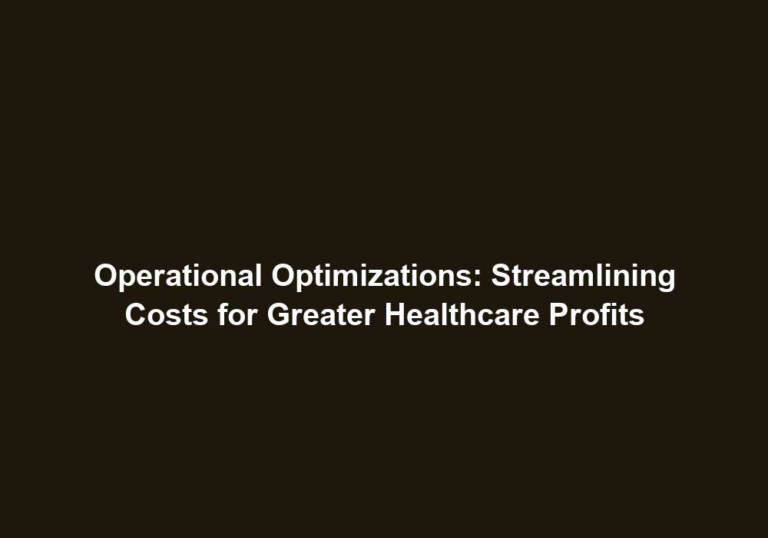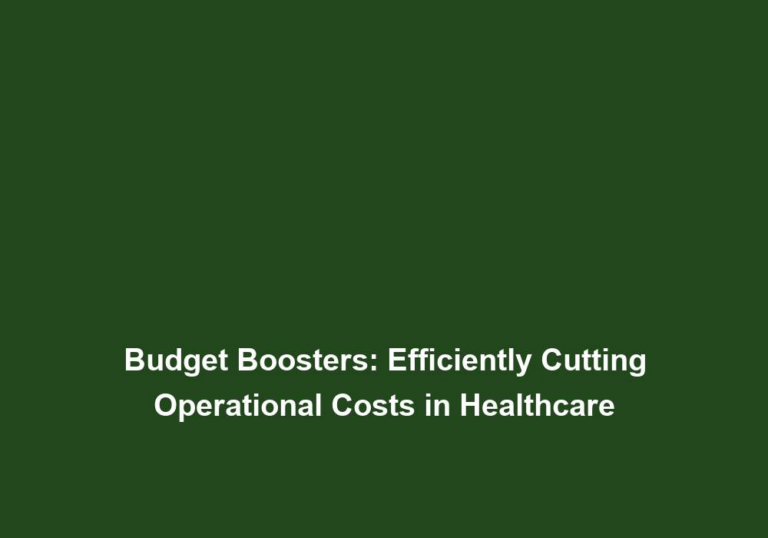Trimming the Fat: Strategies to Streamline Clinic Operational Costs
In today’s rapidly changing healthcare landscape, clinics are constantly looking for ways to optimize their operations and reduce costs without compromising patient care or quality. Trimming the fat from clinic operational costs is a crucial step towards achieving financial stability and long-term success. This article will explore various strategies that clinics can implement to streamline their operational costs effectively.
1. Conduct a Cost Analysis
Before implementing any cost-cutting measures, it is essential to have a comprehensive understanding of your clinic’s current expenses. Conducting a detailed cost analysis will help identify areas where costs can be reduced without sacrificing quality or patient satisfaction.
Some key areas to assess include:
- Staffing costs: Evaluate the ratio of staff to patient volume, identify any redundancies or inefficiencies, and consider outsourcing certain tasks if it proves cost-effective. By optimizing staffing levels, clinics can ensure that they have the right number of staff members available to meet patient demand, avoiding unnecessary idle time and reducing costs.
- Supplies and inventory: Analyze the usage and cost of medical supplies, equipment, and medications. Negotiate better deals with suppliers by leveraging bulk ordering or forming strategic partnerships with suppliers. Implementing inventory management systems can also help reduce waste and excess inventory, leading to cost savings.
- Energy consumption: Assess the clinic’s energy usage and explore energy-saving practices such as installing energy-efficient lighting, adjusting thermostat settings, and upgrading equipment when necessary. By adopting these energy-saving measures, clinics can reduce their utility bills and lower operational costs in the long run.
- Administrative expenses: Review administrative costs such as office supplies, software subscriptions, and professional services. Look for opportunities to consolidate or negotiate better contracts. By centralizing administrative functions and utilizing cost-effective software solutions, clinics can streamline their administrative processes and reduce expenses.
2. Embrace Technology
Incorporating technology into various aspects of clinic operations can significantly reduce costs and improve efficiency. Consider the following technology-driven strategies:
- Electronic health records (EHR): Transitioning from paper-based records to EHR systems can streamline data management, improve accuracy, and reduce storage and administrative costs. EHR systems also enable efficient sharing of patient information among healthcare providers, leading to better coordination of care and reduced costs associated with duplicate tests or procedures.
- Telemedicine: Integrate telemedicine solutions to provide remote consultations, follow-ups, and chronic disease management. This not only improves patient access but also reduces the need for physical space and associated costs. Telemedicine allows clinics to extend their reach beyond their physical location, providing care to patients in rural or underserved areas without incurring additional overhead costs.
- Appointment scheduling software: Implementing automated appointment scheduling systems can optimize staff time and minimize scheduling errors, ultimately reducing administrative costs. These software solutions can also send automated reminders to patients, reducing the number of missed appointments and optimizing clinic resources.
- Online patient portals: Offer online portals for patients to access their medical records, schedule appointments, and communicate with healthcare providers. This reduces the need for administrative staff while enhancing patient engagement and satisfaction. Patients can conveniently access their information and interact with their healthcare team, reducing the need for phone calls or in-person visits.
3. Optimize Staffing
Effective staffing management is crucial in reducing operational costs while maintaining high-quality care. Consider the following strategies:
- Cross-training: Train staff members to perform multiple tasks and responsibilities to minimize the need for specialized personnel. This flexibility allows for better resource utilization and reduces staffing costs. For example, a nurse who is trained in both front desk tasks and patient care can perform a range of duties, reducing the need for separate receptionists or administrative staff.
- Staff scheduling: Optimize staff schedules based on patient demand patterns, ensuring the right number of staff members are available during peak hours while minimizing idle time. By analyzing patient flow data and adjusting staff schedules accordingly, clinics can efficiently allocate resources and avoid overstaffing during slower periods.
- Performance incentives: Implement performance-based incentives to motivate staff members and improve productivity. Rewarding efficiency and cost-saving initiatives can encourage employees to actively contribute to cost reduction efforts. For example, offering bonuses to staff members who identify innovative ways to reduce costs or improve operational efficiency can foster a culture of continuous improvement within the clinic.
4. Streamline Administrative Processes
Efficient administrative processes can significantly impact clinic operational costs. Implement the following strategies to streamline administrative tasks and reduce expenses:
- Automate repetitive tasks: Identify administrative tasks that can be automated, such as appointment reminders, billing, and insurance claim submissions. Automating these processes not only saves time but also reduces the risk of errors and minimizes administrative overheads. By using software solutions or outsourcing certain administrative functions, clinics can streamline their operations and free up staff time for more value-added activities.
- Centralize administrative functions: Consolidate administrative functions, such as billing and scheduling, to minimize duplication and reduce staffing requirements. Centralization also enables better coordination and communication among staff members. By centralizing these functions, clinics can eliminate redundancies and improve overall efficiency.
- Implement effective communication systems: Utilize secure messaging platforms and integrated communication systems to streamline internal communication, reducing the need for time-consuming meetings or excessive phone calls. By implementing efficient communication systems, clinics can enhance collaboration among staff members and reduce communication-related costs.
- Improve billing and coding practices: Ensure accurate and timely billing and coding procedures to minimize denials and rejections. Regularly review coding practices to ensure compliance and maximize reimbursements. By optimizing billing and coding practices, clinics can improve revenue cycle management and reduce the need for costly rework or resubmissions.
5. Collaborate with External Partners
Collaborating with external partners can provide cost-saving opportunities and enhance operational efficiency. Consider the following partnerships:
- Group purchasing organizations (GPOs): Joining GPOs allows clinics to benefit from collective purchasing power, securing better pricing for medical supplies, equipment, and pharmaceuticals. By leveraging the negotiating power of a larger group, clinics can access cost-effective solutions and reduce their procurement expenses.
- Outsourcing non-core functions: Assess which non-core functions, such as accounting, marketing, or human resources, can be outsourced to specialized service providers. Outsourcing can lower costs, increase efficiency, and allow the clinic to focus on core healthcare services. By partnering with external experts, clinics can tap into specialized knowledge and resources, freeing up internal staff for patient care responsibilities.
- Strategic alliances: Explore partnerships or affiliations with other healthcare organizations or clinics. Sharing resources, facilities, or administrative functions can lead to significant cost reductions and improved economies of scale. By collaborating with other clinics or healthcare organizations, clinics can pool their resources and generate cost savings through shared services or joint purchasing initiatives.
By implementing these strategies, clinics can proactively trim the fat from their operational costs, paving the way for financial stability, improved patient care, and long-term success. It is essential to continuously evaluate and reassess these strategies to adapt to evolving needs, industry trends, and regulatory changes.






